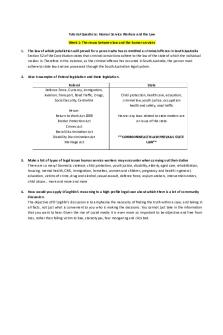EFB344 Tutorial 5 Questions PDF

| Title | EFB344 Tutorial 5 Questions |
|---|---|
| Course | Risk Management and Derivatives |
| Institution | Queensland University of Technology |
| Pages | 2 |
| File Size | 62.9 KB |
| File Type | |
| Total Downloads | 85 |
| Total Views | 138 |
Summary
Tutorial 5 Questions no answers...
Description
EFB344 Risk Management and Derivatives Tutorial 5:
Forwards and Futures 1
Readings:
Hull et al. (2014) Fundamentals of Futures and Options, Ch. 1: 1.1 – 1.4, Ch. 2 and Ch. 3
_________________________________________________________________________________ General Questions: Question 1 What is the primary purpose of the daily settlement of futures contracts?
Question 2 Why are both the buyer and the seller of the futures contract required to establish a margin account?
Question 3 Why might a futures broker require the services of another futures broker when completing customer transactions in the futures market?
Question 4 My portfolio has a beta of 1. Let VA be the value of the portfolio and VF is the notional value of a S&P200 futures contract (F0,T x $25). If I sell perfectly hedged.
V A/V F
futures, discuss whether my portfolio is
Question 5 The beta of an ASX SPI200 futures contract is assumed to be equal to 1 and betas are linearly additive. If I have a portfolio beta of 1.5, why will the purchase of ASX SPI200 futures increase my portfolio beta above 1.5 when the two exposures being combined together have betas of 1 and 1.5?
Question 6 What is the difference between the over-the-counter and the exchange-traded market? What are the bid and offer quotes of a market maker in the over-the-counter market?
Question 7 Suppose you enter into a short futures contract to sell December fine wool for AUD 15.00 per kilogram on the ASX. The size of the contract is 2500 kilograms. The initial margin is $4000, equating to the maintenance margin. If the price of the fine wool futures increases to AUD 15.75 per kilogram, what will be the balance of the margin account? Determine the amount of the margin call, if appropriate.
Question 8 Suppose that in September 2012 an American company takes a long position in a contract on May 2013 crude oil futures. It closes out its position in March 2013. The futures price (per barrel) is $68.30 when it enters into the contract, $70.50 when it closes out the position, and $69.10 at the end of December 2012. One contract is for delivery of 1000 barrels. What is the company’s profit? When is it realised? How is it taxed if it is: (a) a hedger, and (b) a speculator? Assume that the company has a 31 December year end....
Similar Free PDFs

EFB344 Tutorial 5 Questions
- 2 Pages

WEEK 5 ACF Tutorial Questions
- 22 Pages

Tutorial Questions
- 15 Pages

Tutorial 5
- 8 Pages

Tutorial 5
- 2 Pages

Tutorial 5
- 2 Pages

Tutorial 5
- 2 Pages

Tutorial 5
- 6 Pages

Tutorial week 5 chapter 5
- 5 Pages

Tutorial 5 - Lecture notes 5
- 3 Pages
Popular Institutions
- Tinajero National High School - Annex
- Politeknik Caltex Riau
- Yokohama City University
- SGT University
- University of Al-Qadisiyah
- Divine Word College of Vigan
- Techniek College Rotterdam
- Universidade de Santiago
- Universiti Teknologi MARA Cawangan Johor Kampus Pasir Gudang
- Poltekkes Kemenkes Yogyakarta
- Baguio City National High School
- Colegio san marcos
- preparatoria uno
- Centro de Bachillerato Tecnológico Industrial y de Servicios No. 107
- Dalian Maritime University
- Quang Trung Secondary School
- Colegio Tecnológico en Informática
- Corporación Regional de Educación Superior
- Grupo CEDVA
- Dar Al Uloom University
- Centro de Estudios Preuniversitarios de la Universidad Nacional de Ingeniería
- 上智大学
- Aakash International School, Nuna Majara
- San Felipe Neri Catholic School
- Kang Chiao International School - New Taipei City
- Misamis Occidental National High School
- Institución Educativa Escuela Normal Juan Ladrilleros
- Kolehiyo ng Pantukan
- Batanes State College
- Instituto Continental
- Sekolah Menengah Kejuruan Kesehatan Kaltara (Tarakan)
- Colegio de La Inmaculada Concepcion - Cebu





